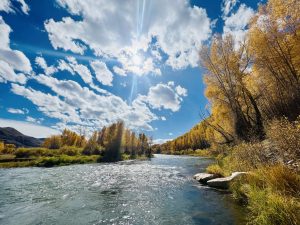Guest commentary — Keeping Routt Wild: when is enough enough?
Keep Routt Wild
We are blessed to live in Routt County, home of the Yampa River, Routt National Forest, Park Range, and the Flat Tops, Sarvis, and Mount Zirkel Wilderness areas. For many people, this is why we choose to live here, surrounded by wildlife, fish and fauna. Across Routt County, we all love the outdoors. But are we loving our wild places to death? A recent study adds further evidence that we are doing so.
The study is a joint project between Rocky Mountain Wild and Keep Routt Wild quantifying the impacts from trail-based recreation on elk habitat in nearby areas of Routt National Forest, and highlighted in a Feb. 24 Steamboat Pilot article. In full disclosure, I was one of the authors of the study, along with Steamboat Springs resident T.J. Thrasher and Rocky Mountain Wild Geographic Information System specialist Alison Gallensky.
The study was based on peer-reviewed research performed by the U.S. Forest Service on elk behavior in the presence of recreational activity. Using radio-collared elk, the original researchers were able to quantify how elk avoided trails and recreationists in the presence of hikers, bikers, equestrians, and ATVs. Our new analysis consisted of superimposing these same “disturbance bands” on roads and trails over the 124,000-acre analysis area just east of Steamboat Springs, an area that supports a great deal of recreation and is home to numerous species of wildlife. These disturbance bands show the distance from the trail that elk would actively avoid depending on the type of recreational activity. This avoidance is a form of habitat loss and compression.
The results indicate a great deal of habitat disturbance and loss from recreational use on trails and roads in the study area, that includes Buffalo Pass and Rabbit Ears Pass. Elk would avoid 60% of the landscape, over 74,000 acres. A flight response from elk could be initiated in over 88% of the landscape, nearly 110,000 acres. In only 12% of the landscape were elk considered undisturbed, a total of 14,000 acres out of 124,000.

Besides the quantitative results, the two-dimensional mapping showed that there were only a handful of undisturbed habitat islands, each separated significantly from the others by areas of human disturbance. This leads to habitat fragmentation and interferes with the natural movement and migration of elk.
Why does this matter?
The impact of human development and recreation on Colorado’s elk herds has been a topic of intense interest in recent years. The Roaring Fork and Eagle valleys elk herds have experienced a 50% reduction in their population since around the year 2000, much of it credited to increased human recreation. “It’s not like these elk walked up and over another hill to another unit,” says former CPW biologist Bill Andree. “They just don’t exist anymore. They’re dead.”
“Why?” asked the Backcountry Journal.
“Increased recreation,” Andree says. “Increased mountain biking and hiking and dog walking in the spring, summer and fall and increased skiing and fat biking and snowshoeing in the winter. Coupled with diminishing habitat, this could mean the end to the herd.”
Locally, Routt County has seen the resident elk herd of GMU-14 decline approximately 30% over the past 15 years. More worrying, the number of elk calves per cow is dropping the same amount, bringing into question whether the herd can remain viable at all.
It’s not just an elk issue. Co-researcher T.J. Thrasher added, “While the study focused on elk, these disturbance bands can be a surrogate for many timid species who share the same habitat, such as dusky and ruffed grouse, mule deer, pronghorn, goshawks, and numerous other raptors. In this regard, we are using elk as a proxy species for the observation and protection of a wide range of species and habitat.”
Perhaps this is the price of progress. As tourism-oriented marketing campaigns bring in more and more visitors to fill our ever-increasing number of trails, the wildlife simply becomes collateral damage. We currently have over 500 miles of single-track bike trails according to the Steamboat Chamber, and are planning for more. But is this worth the cost? The results of the recent Routt County Master Plan survey indicate Routt County residents think otherwise.
“The county needs to balance recreation use and conservation of public lands,” was the top choice of 925 respondents to the question. Last place? “Recreation is more important than conservation.”
When we speak of balancing recreation and conservation, the question becomes, “What is the balance point?” Another way of asking this is, “When is enough enough?”
Indeed, how many trails do we have to build through elk calving areas before we say, enough is enough? How many roadless areas need to be shoveled and scraped before we say enough is enough? How much should we transform our wild areas into visitor-oriented amusement parks before we say enough is enough?
It will not serve the Yampa Valley well to fill our wildlands to their maximum human carrying capacity. As Mountain Journal founder Todd Wilkinson observed, “(That’s) why wildlife disappears. What takes courage, conviction and forward-thinking vision is consciously choosing not to blaze a trail out of respect for animals that have limited home ground to inhabit, and far fewer options to survive than we do to play.”
Routt County can choose our future. We can do comprehensive landscape-level recreation planning to protect our roadless and wild areas for future generations, and set a model for the entire Rocky Mountain west. Or we can witness the continuing loss of wildlife and wild places in Routt County.
The residents of Routt County are asking us to choose wisely.

Larry Desjardin is president of Keep Routt Wild and a resident of Steamboat Springs. Keep Routt Wild’s mission is to promote policies and practices for the benefit of conserving the Yampa Valley for future generations of outdoor enthusiasts by balancing opportunities for recreational development with the habitat needs of wildlife.

Support Local Journalism

Support Local Journalism
Readers around Steamboat and Routt County make the Steamboat Pilot & Today’s work possible. Your financial contribution supports our efforts to deliver quality, locally relevant journalism.
Now more than ever, your support is critical to help us keep our community informed about the evolving coronavirus pandemic and the impact it is having locally. Every contribution, however large or small, will make a difference.
Each donation will be used exclusively for the development and creation of increased news coverage.




